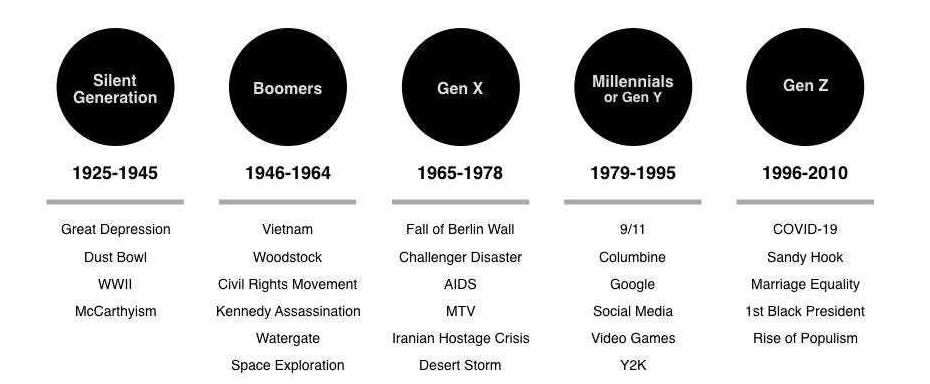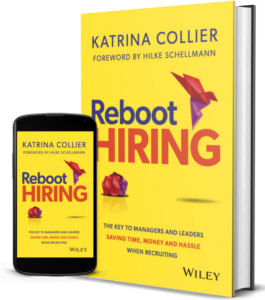If you hear yourself complaining about Gen Z…
We created them.
We enabled them.
We are to blame.
And it’s up to us to adapt because they’re in or entering our workforce.
If we, by we I mean Gen X and Boomers, had had such easy access to the Internet & tech when we were in our late teens/early 20s, we’d probably be the same. If technology had automated the manual tasks we were first employed to do, we’d probably be the same. If we grew up with tech in our hands, we’d probably be the same.
To be crystal clear, this isn’t about typecasting Gen Z!
Because it’s easy to find me ranting about how much I hate generational typecasting and I am as much an expert on Gen Z as I am on any generation. i.e. not at all.
(If you are though seeking generational typecasting n̶o̶n̶s̶e̶n̶s̶e̶, there are circa 1400 Gen Z, 800 Millennial, & 40 Boomer experts on LinkedIn. But just 1 Gen X expert! 🤣)
However, for the sake of the maths below, this is a reminder of the year ranges from Forbes. Though, the year brackets seem to change depending on which source you use. 🤷♀️
Do you see how Gen X & late Boomers, can easily be a parent to Gen Z? 🧐
Many of my Gen X friends have Gen Z kids, and my Boomer (cusp) siblings do too. Not saying Millennials can’t have Gen Z kids but I hear fewer complaints, guess they’re used to being the brunt of everyone’s generational complaints… but I digress. 😬
I suppose we could pass the blame to the creator of the World Wide Web (1989) or the people who created the mobile web (2007), but really, Gen Z grew up with access to the Internet and tech because we, quite literally, handed it to them. 📱
But instead, let’s move onto my point… (I think I have one 😉)
Gen Z is the first truly digital generation
From Pew Research, “Members of Gen Z are more racially and ethnically diverse than any previous generation, and they are on track to be the most well-educated generation yet. They are also digital natives who have little or no memory of the world as it existed before smartphones.”
They have used their devices to be connected in ways we will probably never understand but it’s now an essential part of who they are and how they operate. And because of this, they don’t just want to be told what to do, they want input into things, they want to collaborate, they want purpose, and more.
Don’t we all? 🤷♀️
Didn’t we want the same at their age? But, of course, we couldn’t just reach for our device and look for another job. Our world was different. Their’s is made transparent by the Internet and tech, where ours was opaque, small, less connected.
And just because they aren’t all bought into the ‘hustle culture’ (which we also created), that doesn’t make them lazy. Surely, it makes them smarter for valuing a life of balance? It’s not like life has a dress rehearsal.
It’s time to adapt
And it isn’t easy. We have our own unique set of filters. We grew up with certain thought patterns engrained in our mind, and based on what we learned, observed, and inherited. These neural connections in our brains, have been strengthened over time.
They run like the water does here in the muddy banks of The Thames, via the path of least resistance. No matter how many times the tide goes in and out. The water follows the same familiar path. The one with the least resistance.
Our thoughts do the same. Including your thoughts on ‘Gen Z’. To change them we need to stop and make an effort. And we must because Gen Z have/are entering our workforces. We are interviewing them. We are hiring them. And we can’t ask them to undo what we created by giving them devices. We have to adapt!
Enter design-thinking
Design-thinking aims to address highly complex problems. The kind of problems that refuse to be solved using standard methods and approaches. And we digital immigrants, with our standard methods and approaches, needing to recruit, employ & retain digital natives, definitely falls under highly complex in my book.
After The Robot-Proof Recruiter was published, I was introduced to design-thinking by Chris Raw (💛🙏🏻) and started using it in my workshops. It was the change I needed; every time I sit in awe of the results this methodology and process achieves.
Democratic. Inclusive. Never dull. Design-thinking is a far cry from the world of work most of us entered into. And yet, contrary to the standard methods and approaches ingrained into us by our predecessors, the process consistently delivers high impact, low effort solutions. (Case studies)
And it’s application is wide ranging. Of course, I often use it with clients for candidate experience & recruitment, but it can be used for anything. Future proofing HR, improving hiring manager processes & behaviours, finding out what hiring managers and/or teams really need to excel, and… adapting to a new generation in the workforce? 🤷♀️
Design-thinking can be used for anything that a b̶o̶r̶i̶n̶g̶ meeting isn’t fixing!
And this is just one way we could adapt; there are countless. As we adapted to tech in our workplaces, we must adapt to people who want something different from us as employers.
Because is it so wrong that Gen Z want to work differently or could we learn as much from them as they can from us?
| Part of the Recruitment Isn’t Broken newsletter. For more, be sure to subscribe below, grab Edition 2 of The Robot-Proof Recruiter, check out The Collective, book a workshop or listen to The Hiring-Partner Perspective. |



